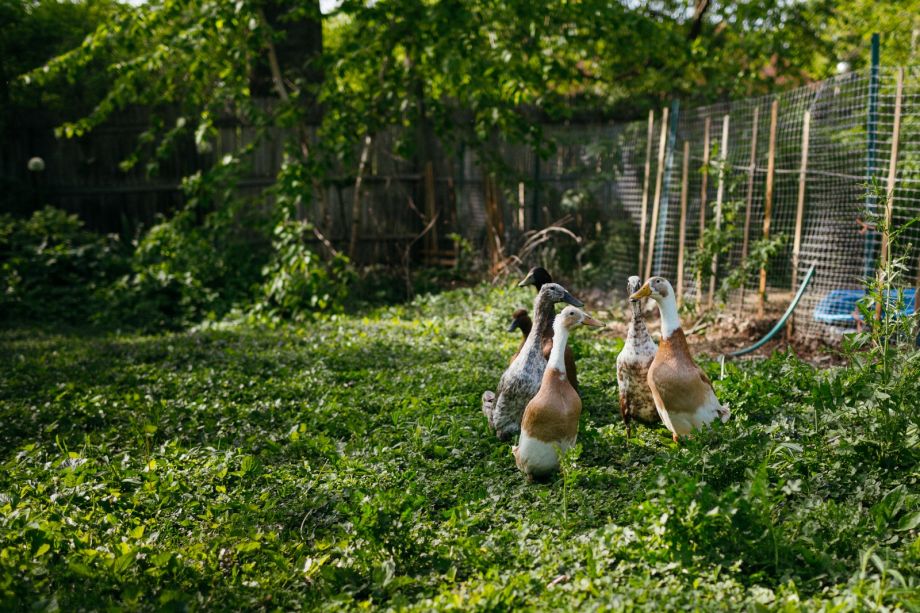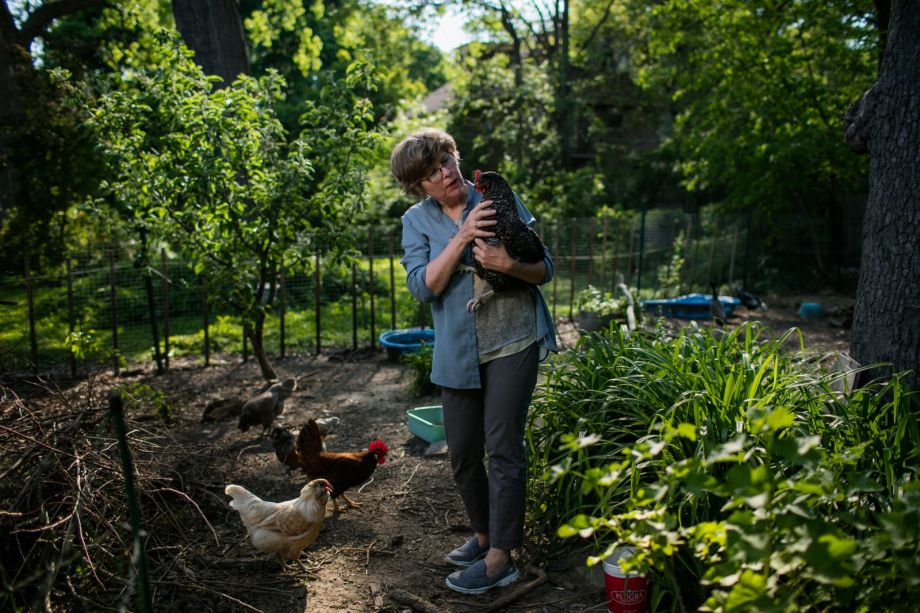Are You A Vanguard? Applications Now Open
This is your first of three free stories this month. Become a free or sustaining member to read unlimited articles, webinars and ebooks.
Become A MemberLaura Mikulski loves her chickens. She keeps three — Dumptruck, Bossy and Crow — in the large yard behind her house in Ferndale, Michigan; they sleep in a coop she built for them and strut and peck in an outdoor run. An organic gardener, Mikulski collects the hens’ eggs and uses their waste as fertilizer, and even jimmied a contraption called a “chicken tractor” that lets her move them around the yard to forage patch by patch.
Mikulski didn’t know anything about chickens when she bought her house in 2005, and researched how to care for them on her own. “When I first was interested in chickens, anybody I mentioned it to thought I was out of my mind,” she remembers. But interest in urban chicken keeping has surged in recent years. Now, she says, “the vast majority of people I talk to, if I mention it off-handedly — or let someone into my backyard to work on the A/C — it starts a conversation: ‘Why chickens? That’s really cool; I’d like to know more.’”
The urban-rural idyll that Mikulski enjoys in Ferndale is elusive, just a few miles away on the edge of Detroit, where keeping chickens is prohibited under city code. Not that Detroiters don’t do it: There are small flocks of chickens, ducks and goats in yards and vacant lots around the city. Detroit’s community of animal keepers is close-knit — many of its members are also active in the urban farm and community garden scene — but they tend to keep a low profile. That’s not surprising, given a much-publicized crackdown by animal control two years ago.
In the fall of 2014, a couple that was raising pygmy goats and chickens in a near-wild section of Detroit’s west side watched as animal-control officers rounded up their animals and took them away. Earlier the same year, as if to prove it didn’t make exceptions, the city had quashed the efforts of a billionaire hedge fund manager-turned-farmer to use his herd of goats to mow vacant land in the Brightmoor neighborhood.
Even at the time, the spokesperson of Mayor Mike Duggan indicated the city was open to changing the policy, which some residents argued was outdated. Now it is poised to do that. Within the next few months, the Detroit Planning Commission will review code amendments that would allow the keeping of certain small animals for agricultural purposes — hens (not roosters), ducks, goats, rabbits and honeybees — on the property of any residence, educational institution, restaurant or agricultural facility that meets spatial guidelines. Slaughter on-site and the sale of meat would not be allowed. Farming with livestock would only be permitted as an accessory use, meaning a person couldn’t buy a property in a residential neighborhood and turn the whole lot into a farm.
After its stop at the Planning Commission, the package will go to the City Council for a vote. Supporters think it is likely to pass.
If it does, the new urban livestock ordinance will be the result of a long and collaborative research process, one that drew on architectural expertise and computer modeling, as well as public feedback, to answer a misleadingly simple question: Where and how should small farm animals be kept in Detroit?
In Detroit as in many cities around the U.S., the newfound interest in livestock keeping has tracked the growth of the local-food movement over the past two decades. But in Detroit, that interest has been heightened by the sheer amount of vacant land — estimated at 20 to 40 squares miles in total — and wedded to the issue of food security, given that 39 percent of city residents live below the poverty line, and access to healthy food is spotty.
Urban farming advocates estimate that there are now 1,400 actively tended gardens and farms around Detroit, up from 80 in 2000. These range from backyard plots to large-scale operations. Earthworks Urban Farm, which started in 1997, grows produce and keeps bees on a 2.5-acre lot on the East Side. D-Town Farm, operated by the Detroit Black Community Food Security Network, grows more than 30 fruits, vegetables and herbs on 7 acres in the northwest part of the city. The massive, long-range Detroit Future City plan, released in 2013, proposed using more vacant land for growing food, among other “productive” uses like solar-panel fields and “blue infrastructure” for stormwater remediation.
Meanwhile, over the past couple of years, Detroit’s white population has risen for the first time since 1950, as young professionals and retirees have moved into neighborhoods like Midtown and Corktown. Although all kinds of Detroiters practice urban farming, its popularity with younger, newer, white residents has led to a wariness of white people trying to “save” the city through farming and of urban agriculture sparking gentrification. (In 2011, a community garden in Midtown was acquired by the doggie daycare business next door and razed; it can be seen as a driver or a victim of gentrification, or perhaps it was both.)
For supporters of raising livestock in the city, the practice is a natural complement to crop cultivation, since manure is a fertilizer, and a great way to teach kids about animals, food systems and nutrition. But despite the appeal of a steady supply of free-range eggs, there are still plenty of people who don’t want farm animals living near them. They worry (understandably) about rats, hens cackling at all hours and bad odors wafting into their living rooms. Many are concerned about the welfare of the animals, especially if one should get loose and wander into traffic — or the path of an unleashed dog. Others find chicken coops unsightly and think they’ll lower their property values.

Diane Van Buren's ducks wander through her backyard.
When farm animals were first prohibited from cities in the 19th and early 20th centuries, it was on the grounds of sanitation and public health, and health concerns have not disappeared: “Although advocates argue that local food can promote public health and sustainability … Concerns about disease and pestilence remain when livestock and people live in close proximity,” writes William H. Butler in an academic paper on urban livestock policies. One commenter on online forum DetroitYES described keeping chickens in the city as “gross, noisy and inconsiderate.”
Malik Yakini, who runs D-Town Farm (and doesn’t raise animals), says notions about class enter into it. “In American society in general, there’s this idea that farming is kind of low-class, or not desirable,” he says. “Typically, people don’t encourage their children to grow up to be a farmer. Also, throughout the world, people view urban life as being superior or more sophisticated than rural life. [Urban livestock] challenges people’s notions of what a city is. Part of the pushback is because people don’t feel like there should be animals in a city, and somehow that’s beneath them or going backwards.”
Detroit is almost 80 percent African-American, and there is a cultural and historical aspect to some of the criticism. “You have people that may have come from the South and don’t necessarily have good memories of their experience in the South, so the whole agriculture, animal thing reminds them of something they wanted to get away from,” says Kathryn Lynch Underwood, a senior planner on the Detroit Planning Commission staff who is African-American.
Underwood is the person coordinating the proposed change in policy. She helped draft an urban agriculture ordinance that became law in 2013. Back then, she and her colleagues thought about adding language to allow livestock, too, but they decided against it when they saw how controversial it would be. They worried it might jeopardize the larger ordinance.
But she took up the idea again in 2014, consulting with stakeholders including city animal keepers, a veterinarian, and farm animal experts from Michigan State University and the state agriculture department. This time, she went in determined to listen to concerns and create a policy that responded to them. After mapping out the basics of the new ordinance, she organized two “Listen and Learn” community meetings in November 2015; about 100 people attended each one, said an animal keeper involved in the process, Diane Van Buren, who raises chickens and ducks in her city backyard. (Underwood sought clemency for the animal keepers in the group during the policy formation process, and officials agreed not to target them, as long as their neighbors didn’t make any complaints.)
Underwood also convened smaller focus groups of animal keepers and people who opposed the idea. There’s “not much gray area” when it comes to attitudes about farm animals in the city, she admits: “People either really want them and feel like they have a right to have them, or people feel like it’s an intrusion upon their neighborhood and aren’t so welcoming.”
At the November meetings, planners and advocates weren’t necessarily hoping to convert skeptics — probably an unrealistic expectation. Instead, they wanted to learn their concerns so they could craft a better policy and minimize the impacts of animal keeping on residents’ quality of life.
Regulating for urban livestock might seem pretty straightforward. Don’t allow large farm animals like cows or pigs in backyards. Put a cap on the maximum number of animals someone can keep in a certain-sized space. Establish health, safety and welfare standards, enforce them — and you’re done. But the more research Underwood did and the more the stakeholders talked, the trickier it seemed.
Pegging the number of animals to a lot’s square footage seems logical, but would that suffice in a city with very different kinds and sizes of lots? Demarcating zones where livestock could be kept was also problematic. What if someone owns a large lot that’s far from other houses, but in an otherwise dense, small-lot neighborhood? Shouldn’t that person be allowed to raise livestock if no one else will be affected by it?
Conversely, Underwood notes, “Just because someone lives in a neighborhood that’s high vacancy doesn’t mean they want animals around them.”
Then there are the hands-on practicalities of raising farm animals: How do you make sure bees don’t escape and fly into the yard next door? What if goats start chewing up flower beds over the property line?
Keeping chickens has always been legal in some cities, like Los Angeles and Minneapolis. Madison, Wisconsin, was one of the first cities to change its code to allow them back in 2004, and since then, as the local food movement has grown, dozens of other municipalities have followed suit. (Some still forbid it, however, like Philadelphia.) One reason Detroit didn’t act sooner was the complexity of passing the urban agriculture ordinance; Michigan has a strong statewide Right to Farm law, and figuring out how to give the city limited local authority within that framework took time.
Detroit’s proposal is unusual in that it would allow a high number and fairly broad range of animals on any lot that meets the spatial requirements. Likewise, it doesn’t tie the number of animals allowed directly to lot size, and doesn’t restrict animal keeping to designated zones within the city.
A Detroit householder will be able to keep a maximum of eight chickens and four goats under the latest draft of the proposal. By comparison, residents of Denver (a city viewed as favorable to urban farmers) can get a license to keep chickens and goats, but their numbers are capped at eight and two. Seattle allows the keeping of eight chickens and three small animals, including cats and dogs, in all zones. Cleveland allows all livestock (except cows in residential neighborhoods), but caps the total number of farm animals — chickens among them — at six on a typical lot. And it doesn’t allow goats in residential districts, except on lots larger than 24,000 square feet.
Underwood was a community gardener and activist herself before it was hip; only recently has she brought that passion to her career as a planner. She sees the policy as a deliberate response to community need. “We went to the animal keepers and said, ‘Okay, we’re going to make a policy, let’s talk about what that looks like.’ And [doing] outreach to folks who don’t necessarily embrace having animals. The intentionality of it is probably different, I’m guessing, than [what] has happened in other communities.” She researched the livestock policies of other U.S. cities that have them. But she wanted Detroit to have a customized policy that reflected local conditions. That’s why she asked the Detroit Collaborative Design Center (DCDC), a community design arm of the architectural school at the University of Detroit Mercy, to help out.
From last fall on, designers at DCDC have worked with the city to develop spatial requirements for the keeping of animals on residential property. They determined appropriate setbacks of three types: from the property line, from the animal keeper’s dwelling and from neighboring dwellings. All three setbacks must be sufficient for a homeowner to keep animals on his or her property. But the formula can adjust to suit different species: For instance, goats require the farthest setback from neighbors, meaning some lots would qualify for chickens, but not for goats.
DCDC also helped guide per-animal shelter and pen space requirements, and the rule that outdoor pens (for hens, ducks and goats) can’t be more than twice as long as they are wide, to avoid galley-like runs and give the animals space to move in all directions. The design guidelines call for flyway barriers for beehives (unless they’re 25 feet from the property line) and a short setback at the property line, to counter the nibbling goat problem.
A landscape architect on DCDC’s staff, Charles Cross, compiled a list of flowering and fragrant plants that would make good buffers for yards with livestock and reduce their visual and olfactory impact. He’s also looking into landscape strategies that could mitigate runoff, says Christina Heximer, the associate director of the design center.
In mid-May, Underwood joined DCDC designers on a field test, visiting a variety of neighborhoods, tape measures in hand, to see how the setbacks looked in the real world. The result: a little too close for comfort. (They increased the neighboring dwelling setback.)
Meanwhile, Food Plus Detroit, a nonprofit that collaborates with the city government, teamed up with Michigan State University to conduct rigorous analysis on the known unknowns of urban livestock’s future. Laura Schmitt Olabisi, an assistant professor in MSU’s Department of Community Sustainability, used a predictive method system dynamics modeling. Common in the business world, this kind of modeling can capture multidirectional causation, Olabisi says: “A causing B, but B coming back and affecting A.”
The researchers posed two questions. First, how many people are likely to adopt urban livestock if it becomes legal? Second, how strong would opposition be in various scenarios (e.g., if animal keepers had training in best practices versus if they didn’t)?
To forecast the potential number of animal keepers in 10 years’ time, Olabisi scoured data on household and lot characteristics (sorting for those in single-family homes on lots that might qualify for animal keeping), and folded in feedback from the community meetings. “We estimated that between 1,000 and 3,000 households out of about 256,000 total would probably keep chickens. About 1 percent. So we’re not talking about a huge percentage of Detroit households here,” she says. Even if it’s just a prediction, it should put to rest any fears of the city being overrun with farm animals.
Looking at opposition to the rule under different scenarios, the model predicted that good training for animal keepers, offered promptly, would stem many problems and complaints. “The best way to keep animal keepers in compliance and keep opposition to a low would be to reduce the amount of time it takes to train people,” Olabisi says. “In other words, it’s really important to roll out training and education programs as fast as possible.”
Underwood has thought about a way to accomplish that. She wants to create an urban livestock guild of experienced animal keepers, whose members could swap advice and serve as liaisons to the community (and City Hall). The guild model is, as far as Underwood knows, unique. One of its main functions would be to train and certify new farmers. It would not be responsible for enforcement, however; that would continue to be carried out by the city, although the specifics, such as inspection schedules, are still being worked out. The DCDC will pass its design guidelines — with plenty of easy-to-understand diagrams — to the guild for use as a training aid.
Mark Covington, a community gardener and animal keeper in the city, expects to serve as a guild member once the ordinance passes. “We’ll police ourselves as livestock keepers; that way it won’t be a burden on animal control or the police,” he says.
Covington runs the nonprofit Georgia Street Community Collective gardens in northeast Detroit. He got into urban agriculture almost by accident, cleaning litter out of empty lots in the neighborhood where he grew up. That led to gardens and a fruit orchard that cover five lots; he now raises goats, ducks and chickens, and has started an apiary. The collective offers Chickens 101 classes to would-be farmers and regularly invites local kids to meet and learn about the animals.
“There’s a lot of urban agriculture going on in the city,” Covington says. “I know, reading up on the past history of Detroit and the reason why they stopped [allowing animals], a lot of people deemed it as a poor person’s avenue to save money. … I know there’s some people who would want to raise livestock for food, but for the majority, it’s not like that — I’m not saying that’s a bad thing, either.
“We teach the kids where their food comes from. They can come and see what a goat looks like, what a chicken looks like.”
Covington thinks the nuisance factor of urban livestock is lower than people may imagine. As we talk on the phone, he notes, “I’m sitting 10 feet from the goats, 20 feet from chickens and ducks.” What I hear on the other end is a dog barking in the distance.
Covington’s roots in the neighborhood have helped him avoid friction, but he says he’s proactive about outreach nonetheless. “The neighbors that I’m around, I’ve either known them almost my whole life, or when they come in, I definitely engage them. I make sure they know who I am and what I’m doing.” For him, being a good neighbor extended to raising money for the burial of a local teen who was killed, and rallying around his family. That generosity, in addition to the physical transformation of Georgia Street, has impressed city leaders — one reason Covington feels comfortable continuing to keep animals and talking on the record about it.
Van Buren, the other not-quite-legal animal keeper, agrees with Covington on the importance of neighbor relations. She cleared her plan to raise chickens and ducks with her neighbors, even though she has a quarter-acre of land. She believes that livestock keeping can be part of a good urban revitalization strategy for Detroit. One thing Detroit has plenty of is vacant land. Some blocks have only a few houses left on them, due to abandonment and the city’s policy of demolishing blighted structures. Agriculture gives vacant lots a purpose, improves their appearance and can make them into community gathering places.

Diane Van Buren stands with her chickens in her garden.
Keeping animals can speed up the remediation of land, especially post-industrial land, argues Van Buren, a local urban-redevelopment consultant. “Just like in nature, they’re part of the regeneration of the soil,” improving its health by fertilizing and aerating it. Olabisi’s report notes the “potential economic multiplier benefits” of an urban livestock ordinance: “Urban livestock keepers would need access to supplies and services that could create jobs and recirculate money within the local economy,” she and her co-authors write. It’s still too early to make the economic case for livestock, or urban agriculture more broadly, Underwood says, but that’s “definitely the next step.”
Van Buren believes the guild — which she expects to join — will play a vital role in providing education where there’s currently a gap, with sometimes sad consequences.
“I’ve seen cases where there’s a big batch of chicks, and I’d hear back a month later — they all died, they disappeared. My gosh, what did you do? [New animal keepers] are not necessarily prepared” to deal with sickness and predators, she says.
Even experienced backyard farmers can lose their animals. If foxes are a constant threat to chickens in the countryside, urban areas offer a host of other predators: raccoons, dogs, possums and hawks. The importance of keeping hens safe from aerial attack is something a new chicken keeper might not glean from blogs or YouTube. It’s why Mikulski built her chicken tractor — to protect the chickens from swooping hawks during the day. (A fully enclosed coop protects them at night, while keeping out rats.) Detroit’s winters are harsh, and Mikulski recommends people keep no fewer than three chickens so they can huddle up for warmth, but in fact, chickens cope with cold temperatures better than summer heat, which can tax their respiratory systems.
Yakini is considering getting chickens and goats for his farm if the ordinance passes, and says the initial rollout will determine its longer-term success. “To the extent that people do it well … I think the opposition will be lessened over time. Things take a while to seep into the public consciousness. If it’s not done well … we could have even more staunch opposition.” And some Detroiters are never going to come around, he believes. “Some people are going to have a problem with it no matter how well it’s done.”
Ferndale is much smaller than Detroit and has climbed a learning curve since it legalized backyard chickens four years ago. Mikulski led the push for her city to allow chickens, and at first, not everyone was convinced. The code enforcer who inspects her facilities “thought I would bring in rats by the truck full.” Now, she says, “he seems to actually enjoy his quote-unquote-chicken day” every year. “He comes through and inspects every coop. We have a nice talk. He feeds the chickens a couple of little treats.”
Apart from one local hen she’s heard of that occasionally goes on walks, Mikulski says she’s not aware of any problems. And adoption has been limited, in line with Olabisi’s model. “I don’t think we’ve had a huge amount of adoption. There are maybe 20 chicken keepers in the city.”
What’s clear is that by changing their rules about animal-keeping, Detroit and other cities are doing something more symbolic at the same time. They are blurring the rigorous separation of uses in Euclidean zoning, poking small but unmistakable holes in the conventional definitions of urban versus rural land, residential versus agricultural uses. For Detroit and for the country as a whole, that’s going to take some getting used to.
This article is part of a Next City series focused on community-engaged design made possible with the support of the Surdna Foundation.

Amanda Kolson Hurley is a freelance writer in Silver Spring, Maryland. Formerly an editor at Architect and Preservation magazines, she has contributed to a wide range of publications including the Washington Post, Architectural Record, The Architect’s Newspaper and the Times Literary Supplement.

Michelle & Chris Gerard are photographers residing and working in Detroit. The passion they have for the city has led them to work with many Detroit businesses, non-profits, publications, and create storytelling images on a daily basis.

20th Anniversary Solutions of the Year magazine